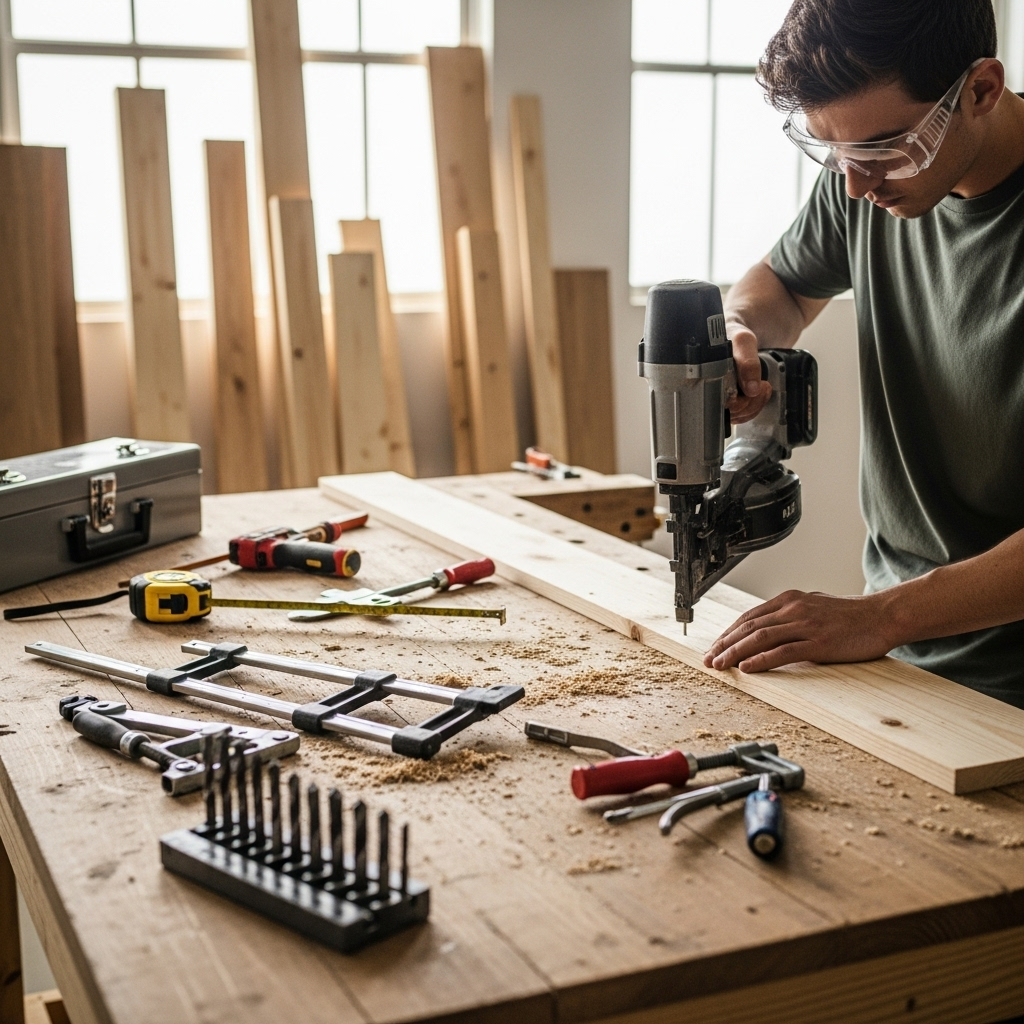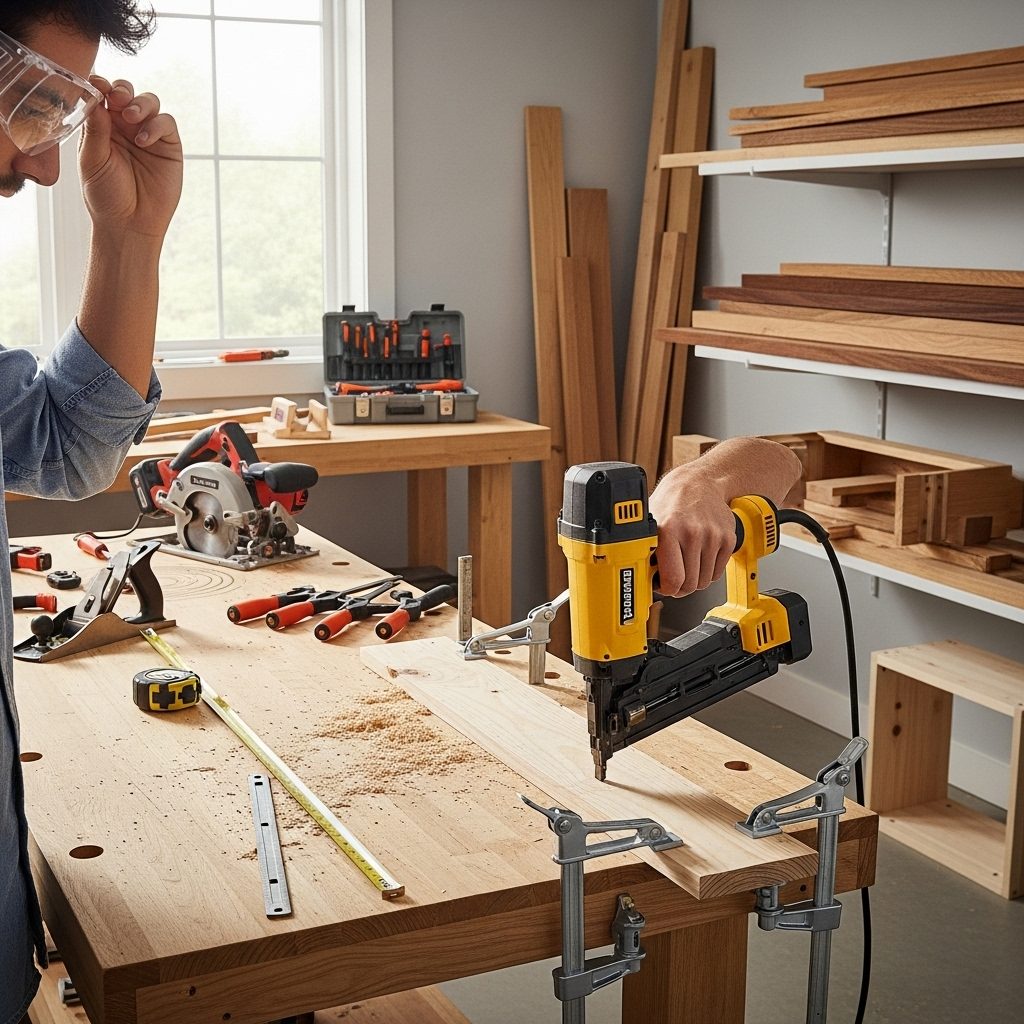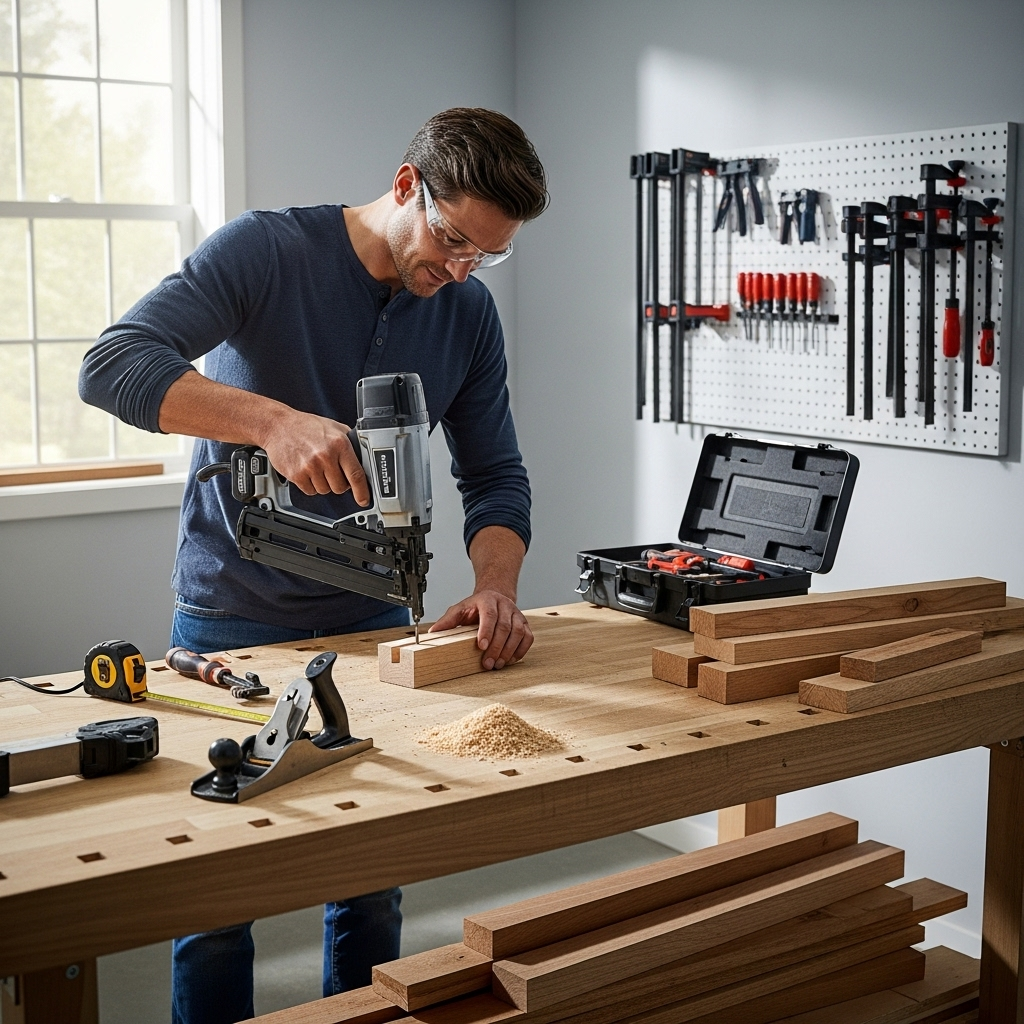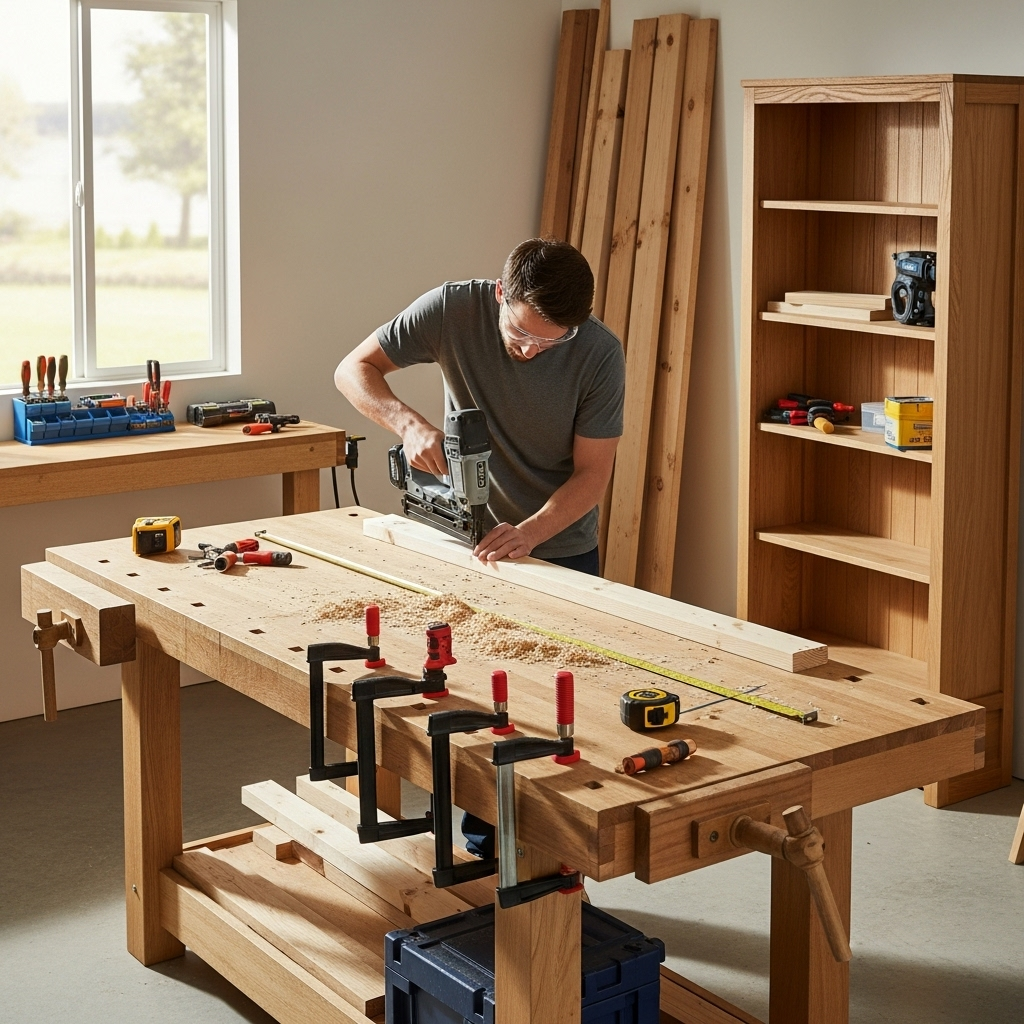Quick Summary: Laminate Wood Flooring vs Vinyl
Choosing between laminate wood flooring and vinyl is a common DIY dilemma. Laminate offers a realistic wood look with a durable overlay, while vinyl provides superior water resistance and comfort. Both are budget-friendly and DIY-friendly, but vinyl often wins for high-moisture areas.
Hey there, DIYers! Jack Shaffer here from Nailerguy. Tackling a flooring project can feel like a big undertaking, and one of the first big decisions you’ll face is choosing the right material. Laminate wood flooring and vinyl flooring are two of the most popular options for homeowners, and for good reason. They both offer great looks without breaking the bank, and they’re often manageable for us DIY folks. But navigating the differences can be a bit confusing. What works best for your busy family room? What stands up to spills in the kitchen? Don’t sweat it! We’re going to break down laminate wood flooring vs vinyl, clear up any confusion, and help you make the perfect choice for your home. Let’s get started!
Table of Contents
Laminate Wood Flooring vs Vinyl: Your Essential Guide to Choosing Wisely
Picking new flooring can be exciting, but also a little overwhelming. You want something that looks fantastic, lasts a long time, is easy to take care of, and fits your budget. Laminate and vinyl flooring both tick a lot of those boxes, but they’re quite different under the hood. Understanding these differences will help you choose the perfect floor for each room in your house. We’ll dive deep into what makes each one tick, so you can feel confident in your decision.
What Exactly is Laminate Wood Flooring?
Laminate flooring isn’t made of real wood, but it’s designed to look just like it! Think of it as a high-tech sandwich. The core is usually made of high-density fiberboard (HDF), which is essentially compressed wood particles. On top of that core, there’s a decorative layer that’s printed with a realistic wood grain picture. And the very top layer? That’s a super tough, clear protective coating called a wear layer. This wear layer is what protects the pretty picture underneath from scratches, stains, and fading.
Because of this construction, laminate can mimic almost any type of wood, stone, or tile you can imagine. The printing technology has gotten incredibly good, so some laminate floors look remarkably like the real thing. It’s a popular choice because it’s generally more affordable than hardwood, yet it can give you that warm, natural wood aesthetic.
Pros of Laminate Wood Flooring:
- Realistic Appearance: Excellent reproduction of wood grains and textures.
- Durability: The tough wear layer resists scratches, dents, and stains well.
- Affordability: Generally less expensive than hardwood or higher-end engineered wood.
- Ease of Installation: Many types use a click-and-lock system, making DIY installation straightforward.
- Maintenance: Easy to sweep and mop.
Cons of Laminate Wood Flooring:
- Water Sensitivity: Not ideal for very wet areas like bathrooms or basements because moisture can cause the HDF core to swell and warp.
- Can Feel Hard: It doesn’t have much give underfoot, which can feel less comfortable than other options.
- Scratch Resistance Varies: While durable, deep scratches can be difficult or impossible to repair.
- No Refinishing: Unlike real hardwood, laminate cannot be sanded down and refinished if damaged.
What Exactly is Vinyl Flooring?
Vinyl flooring has come a long way! What used to be known as cheap, flimsy linoleum is now a sophisticated and versatile flooring option. Modern vinyl is usually made from PVC (polyvinyl chloride) and comes in various forms, most commonly Luxury Vinyl Tile (LVT) or Luxury Vinyl Plank (LVP). These are designed to mimic wood, stone, or tile with incredible accuracy.
Vinyl flooring is typically constructed in layers as well. It has a backing layer, a core layer (which can be solid PVC or a composite), a printed design layer, and a thick wear layer on top. The advanced printing and embossing techniques allow vinyl to replicate the look and feel of natural materials so well that it can be hard to tell the difference. LVT and LVP are particularly popular because they come in planks or tiles that can be installed using a click-and-lock system, just like laminate.
Pros of Vinyl Flooring:
- Excellent Water Resistance: This is vinyl’s superpower! It’s nearly waterproof, making it perfect for kitchens, bathrooms, laundry rooms, and basements.
- Durability: The wear layer is very resistant to scratches, scuffs, and stains, making it great for high-traffic areas and homes with pets and kids.
- Comfort: Vinyl tends to be softer and warmer underfoot than laminate, providing a more comfortable surface.
- Ease of Installation: Many LVP and LVT products use a click-and-lock system, making them very DIY-friendly.
- Maintenance: Extremely easy to clean and maintain with simple sweeping and damp mopping.
- Affordability: Often very budget-friendly, especially compared to natural materials.
Cons of Vinyl Flooring:
- Can Be Punctured: While resistant to scratches, very sharp or heavy objects dropped on it can potentially puncture or dent vinyl.
- Fading Potential: Though less common with quality products, prolonged direct sunlight can sometimes cause fading over many years.
- Not Natural: It’s a synthetic material, which some people prefer to avoid if looking for natural products.
- Cannot Be Refinished: Like laminate, deep damage means replacing the plank or tile.
Laminate Wood Flooring vs Vinyl: The Head-to-Head Comparison
Now that we know a bit about each, let’s put laminate wood flooring and vinyl head-to-head on some key factors that matter to homeowners. Think of this as your cheat sheet for making the best choice for your project.
| Feature | Laminate Wood Flooring | Vinyl Flooring (LVT/LVP) |
|---|---|---|
| Appearance | Excellent wood look; high-definition printing. Can also mimic stone/tile. | Excellent wood, stone, and tile looks; realistic textures. |
| Water Resistance | Fair to good. Not ideal for high-moisture areas. Can swell. | Excellent. Water-resistant to waterproof, depending on product. Ideal for wet areas. |
| Durability (Wear Layer) | Good to very good. Resists scratches and fading well. | Very good to excellent. Resists scratches, scuffs, and stains exceptionally well. |
| Comfort Underfoot | Firm and can feel harder. | Softer and warmer. Some products offer attached underlayment for extra comfort. |
| Installation | Mostly DIY-friendly click-lock systems. Requires a flat subfloor. | Mostly DIY-friendly click-lock systems. More forgiving of minor subfloor imperfections. |
| Cost | Generally very affordable. | Affordable to mid-range; often comparable to laminate, sometimes slightly more for premium options. |
| Repairability | Challenging. Deep damage requires plank replacement. Cannot be refinished. | Challenging. Deep damage requires plank/tile replacement. Cannot be refinished. |
| Best For | Living rooms, bedrooms, hallways, home offices. Areas with moderate foot traffic and low moisture. | Kitchens, bathrooms, basements, entryways, high-traffic areas, homes with pets/kids. |
Key Factors to Consider for Your Project
When you’re standing in the flooring aisle, or browsing online, keep these points in mind. They’ll help you match the material to your home’s needs.
1. Location, Location, Location!
This is probably the biggest deciding factor in laminate wood flooring vs vinyl. Where are you installing this new floor?
- High-Moisture Areas (Bathrooms, Kitchens, Laundry Rooms, Basements): Vinyl is the clear winner here. Its waterproof qualities mean spills and humidity are far less likely to cause damage. Laminate can swell and warp if moisture seeps into its core. You can find specialized waterproof laminate options, but true vinyl is generally the safer bet for these spots.
- High-Traffic Areas (Hallways, Entryways, Family Rooms): Both can do well, but vinyl often has a slight edge due to its excellent stain and scuff resistance. Quality laminate with a good wear layer is also a strong contender.
- Low-Traffic Areas (Bedrooms, Home Offices): Both are excellent choices. You have more freedom to choose based on aesthetics and budget here.
2. Ease of Installation
Are you a seasoned DIYer, or just starting out? Both laminate and vinyl often come with click-and-lock systems. This means planks or tiles “snap” together without glue or nails, making them very beginner-friendly. You’ll typically need a saw (like a jigsaw or miter saw) to cut pieces to size, a measuring tape, and possibly a tapping block and pull bar.
Vinyl can sometimes be more forgiving of slightly uneven subfloors than laminate, which often requires a very flat surface to prevent gaps or damage to the locking mechanism. Always read the manufacturer’s installation guide carefully!
For more on ensuring a flat subfloor, the Building Science Corporation offers great insights.
3. Durability and Maintenance
How tough does your floor need to be? If you have pets that shed and scratch, energetic kids, or a busy household, you’ll want something that can take a beating.
Both laminate and good-quality vinyl have a protective wear layer that resists everyday wear and tear. However, vinyl’s wear layer is often more resilient to moisture and scuffs. Laminate’s wear layer is tough but can be scratched deeply by items like sand or gravel tracked in from outside. Once a laminate plank is deeply scratched or gouged, it’s hard to fix without replacing it. The same is true for vinyl, though deep gouges might be slightly more common on vinyl from extremely sharp impact.
Maintenance for both is super simple: sweep regularly and damp mop. Avoid excessive water on laminate.
4. Comfort and Feel
Do you prefer a floor that feels a bit softer underfoot? Vinyl generally has a slight advantage here. It has more “give” than laminate, making it feel warmer and more comfortable to stand on for long periods. Many vinyl products also come with an attached underlayment, which adds to both comfort and sound insulation.
Laminate can feel quite hard compared to vinyl. While you can install an underlayment beneath laminate to add a bit of cushion and improve sound dampening, it won’t change the inherent firmness of the material itself. For areas where comfort is a top priority, like a kitchen where you stand to cook, or a playroom, vinyl might be the better choice.
5. Budget and Aesthetics
Both laminate and vinyl are fantastic budget-friendly options compared to real hardwood, stone, or high-end tile. Generally, entry-level laminate and vinyl can be very close in price.
As you move up in quality, both materials can increase in price, with premium vinyl options sometimes costing more than mid-range laminate. What truly influences price is the quality of the wear layer, the realism of the design, and any added features like enhanced water resistance or attached underlayment.
Appearance is subjective: Both offer stunning realism. Laminate excels at mimicking the detailed grain patterns of exotic hardwoods. Vinyl is superb at replicating both wood and stone textures so accurately you might need to touch it to tell the difference. Look at samples in your own home’s lighting to see which look you prefer!
Choosing the Right Type: Laminate or Vinyl for Specific Rooms?
Let’s think room-by-room to make it even clearer:
- Kitchens: Vinyl. The kitchen is prone to spills from sinks, cooking, and drinks. Vinyl’s waterproof nature makes it the ideal choice to prevent water damage and stains.
- Bathrooms: Vinyl. This is the wettest room in most houses! Vinyl is the undisputed champion here. Look for specific water-resistant or waterproof vinyl flooring.
- Living Rooms/Family Rooms: Either! This is a great place for laminate wood flooring if you love the hardwood look and your budget is tight. Vinyl is also a fantastic choice, especially if you have kids or pets, due to its superior stain and scuff resistance.
- Bedrooms: Either! Both offer warmth and style. Consider comfort – vinyl might feel a bit softer and warmer underfoot, which is lovely in a bedroom.
- Basements: Vinyl. Basements can be prone to moisture issues. Vinyl’s waterproof properties make it the safer and more durable option.
- Hallways/Entryways: Vinyl is often preferred due to exceptional durability and resistance to tracked-in dirt and moisture. However, a quality laminate with a high AC rating (Abrasion Criteria) can also hold up well.
Understanding Wear Layers and AC Ratings
When comparing laminate and vinyl, you’ll often see terms like “wear layer” and “AC Rating.” These are important indicators of durability!
- Wear Layer (Vinyl): On vinyl flooring, the wear layer is measured in mils (thousandths of an inch). A thicker wear layer (e.g., 20 mil or higher) generally means better resistance to scratches, scuffs, and stains. For residential use, 12 mil is often sufficient, but 20 mil or more is recommended for high-traffic areas or homes with pets.
- AC Rating (Laminate): For laminate flooring, durability is measured by an AC (Abrasion Criteria) rating. This rating system is standardized and tells you how resistant the laminate is to wear, scratches, and fading.
- AC1: Suitable for light residential use.
- AC2: Suitable for general residential use.
- AC3: Suitable for heavy residential use (most common and recommended for living areas).
- AC4: Suitable for heavy residential and moderate commercial use.
- AC5: Suitable for heavy commercial use.
For most homes, an AC3 or AC4 rating for laminate is a safe bet. For vinyl, look for a wear layer of at least 12 mil, preferably 20 mil for high-traffic areas.
You can learn more about flooring durability standards from organizations like the Good Housekeeping Institute, which often tests and reviews flooring.
Installation Tips for DIYers
Whether you choose laminate or vinyl with a click-lock system, here are some general tips to help your installation go smoothly:
- Acclimate the Flooring: Let the boxes of planks or tiles sit in the room where they’ll be installed for at least 48 hours (check manufacturer instructions) to adjust to the room’s temperature and humidity. This prevents expansion or contraction issues later.
- Prepare Your Subfloor: Ensure your subfloor is clean, dry, and level. Remove any old flooring, nails, or staples. For laminate, a very flat subfloor is crucial. Slight imperfections might need to be leveled.
- Lay Underlayment (if needed): Many click-lock floors have attached underlayment. If not, install a recommended underlayment for cushioning, moisture barrier (if required), and sound reduction.
- Plan Your Layout: Start in a corner and work your way across the room. Decide which direction the planks will run (usually parallel to the longest wall or the main light source).
- Cut Wisely: Measure carefully for cuts needed at walls and around obstacles. A jigsaw or a miter saw is usually best for this. Remember to cut from the top side for laminate to prevent chipping the decorative layer.
- Stagger Your Seams: Just like with building walls, stagger the end joints of your planks to make the floor stronger and more attractive. Aim for at least a 6-inch stagger.
- Use the Right Tools: A tapping block and pull bar are essential for ensuring the planks lock together tightly without damaging the edges.
- Leave Expansion Gaps: Most floating floors (like click-lock) need a small gap around the perimeter of the room to allow for expansion and contraction.



